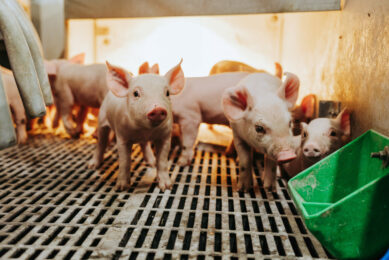Necrosis and long tails do not go well together
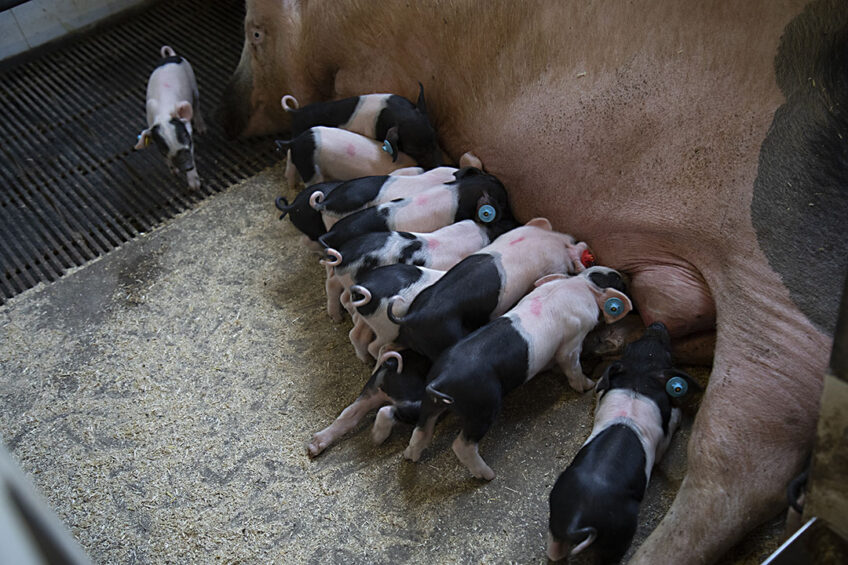
Keeping long tails is only possible on farms that do not suffer from (ear or tail) necrosis, a phenomenon also known as SINS. This conclusion can be drawn with knowledge that is currently available.
Formally, tail docking is not allowed in the Netherlands – only under exceptional circumstances it can be performed. In practice, however, that results in routine docking being done on a relatively large scale. That practice, however, is very likely to end in 2030. As a result, the pig farming industry must find a way to be able to keep pigs with long tails. That is a challenge, as research shows that some form of necrosis is present on virtually all farms.
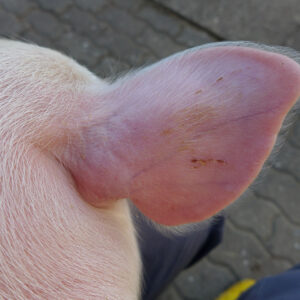
Blood flow problem
Necrosis is a form of tissue loss, that can result from a blood flow problem caused by a damaged, leaky gut that allows endotoxins to enter the bloodstream and cause excessive inflammatory responses and circulatory disorders.
“Various stress factors can be the cause of this leakage: heat stress, a nutritional transition, but also an infection by, for example, PIA [porcine intestinal adenomatosis – also known as ileitis]. Additional changes in the intestinal microbiome can also trigger (tail) biting by pen mates,” says Rutger Jansen of animal health company Boehringer Ingelheim. “All factors together can cause the bucket to overflow.”
It’s not only pigs that are sensitive to this; in horses, for example, intestinal problems can lead to laminitis. In cattle, claw problems can arise because of subclinical rumen acidosis, also known by the abbreviation SARA (sub acute ruminal acidosis), which releases endotoxins into the bloodstream.
German research
Veterinarian and geneticist Professor Dr Gerald Reiner, head of the pig department at the Justus Liebig University in Giessen, Germany, named the syndrome Swine Inflammation and Necrosis Syndrome (SINS) and is conducting research into its genetic cause. That research goes beyond just the character of the boar line. SINS is a combination of clinical inflammation from within and the presence of dead tissue or necrosis.
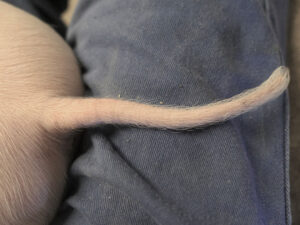
German research into SINS is a priority
Mirjam Lechner, consultant and animal signal trainer, works closely with Prof Reiner in SINS research and indicates that many factors are important in the approach to SINS. “First, attention to the genetic factor is needed to be able to keep commercial pigs with long tails,” Lechner says. The fact that a solution for SINS is high on the German agenda is shown by the fact that a lot of money is available in the federal states for research and keeping animals with long tails. Bavaria invests more than € 1 million in a breeding project to score animals on SINS using genetic testing.
In addition to paying attention to factors that trigger animals to bite out of discomfort – such as stress, a bad climate, overcrowding or nutrition – more attention is now being paid to SINS in the Netherlands. Breeding organisation Topigs Norsvin focuses much of its attention on behaviour and includes SINS in an ongoing study.
SINS in newborn piglets
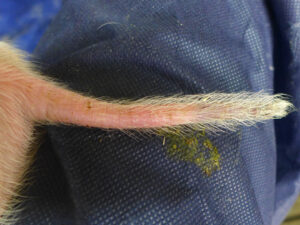
“With SINS, all factors come together, including genetics, pen design, climate, feed composition, mycotoxins, roughage, pen enrichment, but also water supply,” says Karien Koenders, veterinarian at the Lintjeshof practice, headquartered in Nederweert, in the south of the Netherlands. “For me, SINS provides a biological explanation for (intestinal) infections from within and also provides leads for the future to keep animals with long tails.” That starts with the gestation period and the newborn piglets.
Koenders now looks at the piglets differently and inspects, among other things, the ears and claws of newborn piglets. “To detect the syndrome, we use a thermal camera, which shows for example swollen warm blood vessels in the ears. Eventually, the small blood vessels in the ear tips can become blocked by the inflammation. Then the blood flow is disrupted, and we see a cooler image at the height of the ear and tail tips. I see the symptoms of SINS in newborn piglets on every farm, to a greater or lesser extent,” says Koenders. “A piglet born with SINS is already 1-0 behind in the context of ear or tail necrosis.”
The approach to the solution will be different on every farm. It might be lowering pen stocking, providing more roughage or more and better pen enrichment or giving clay minerals to bind mycotoxins. What applies to every company is that water intake must be increased. Especially for the weaned piglets, this is the number #1 priority to be able to dispose of waste.
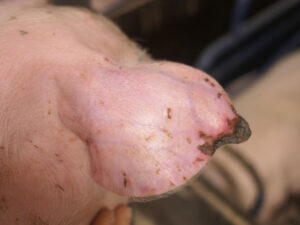
Ear necrosis in weaned piglets
Animal nutrition company Agrifirm is also active in monitoring weaned piglets in combination with thermal images. “At the moment we are less involved with SINS in newborn piglets and sows, which is something for the long-term focus,” says Tim van Sprang, veterinarian and sales manager at Agrifirm. “We focus on a good start after weaning, with which we want to prevent diarrhoea and promote good intestinal health. In addition, we strongly suspect that thermoregulation of the piglet also has a major influence on the development of ear necrosis in weaned piglets,” says Van Sprang.
“In the thermal camera images we take, we see that piglets in units where ear necrosis develops clearly have warmer ears than in units without ear necrosis. We strongly suspect that a piglet first develops a fever, and that ear necrosis develops after that.” Agrifirm also uses the Healthy Climate Monitor, which monitors the climate in the barn 24 hours a day in combination with camera images.
A solution for ear and tail biting is not only necessary for the animals’ well-being; there is also an economic aspect at play. A piglet with ear necrosis is more difficult to sell, especially in tough economic times. A finisher with a bitten tail also does not fit into a welfare concept with long tails as a requirement. In addition, a pig with an open wound is not allowed to be transported, not even to the slaughterhouse. At the same time, an immune and inflammatory response means an extra need for feed (amino acids and energy) for the body, reducing feed intake and efficiency.





